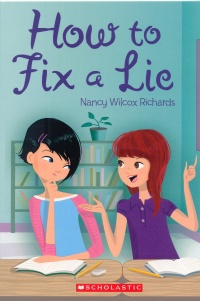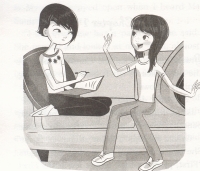| ________________
CM . . . . Volume XVIII Number 30 . . . . April 6, 2012
excerpt:
Life is looking pretty good for Abby. School is almost out for the summer, and, in the meantime, she's looking forward to participating in her class's special "Pioneer Day" with the rest of her third grade friends. Things take a definite turn for the worse, however, when she gets stuck in the same pioneer family as Gracie, the most unpopular kid in the class. While Abby tries to give her a chance, Gracie's habit of telling lies makes it difficult to believe anything she says. In How to Fix a Lie, Nancy Wilcox Richards develops themes of acceptance, forgiveness, and trust, as both girls learn lessons about what it means to be a good friend.
Since the narrative stays closely focused on Abby and Gracie's interactions, the rest of their classmates remain fairly undeveloped as characters. However, it is good to see ethnic diversity being portrayed very naturally in both the text and illustrations, even when it is not a major focus of the story. One of the strengths of How to Fix A Lie is the realistic touches that will allow kids to identify with Richards' characters, such as Abby's anxiety over picking the right partner for a class activity. While Abby's continuous compassion and maturity sometimes seem a bit idealistic, Gracie's character has an authentic feel; her imagination and high emotions lead her to tell lies, even when she doesn't intend to cause any trouble. In a way that is typical of kids in this age group, Gracie also has trouble figuring out her own motivations for acting in hurtful ways, such as when she excitedly pinches Abby but is later at a loss to explain her actions. In fact, Richards does not attempt to resolve these uncertainties by providing pat answers or further backstory. Even when it becomes apparent that some of Gracie's outrageous stories have actually been true, the lack of explicit explanation for Gracie's lying problem may leave some young readers with outstanding questions. However, Richards does succeed in giving a level of emotional complexity to her characters. Black and white spot illustrations appear every few pages or so. Annabelle Métayer's fashion art background can be seen in the hip hairstyles and poses of the kids depicted in these digital art images. While the illustrations mainly represent rather than extend the text, the characters depicted have an expressiveness that adds to the story. On the level of language, Richards's lively tone is appealing, although her use of terms like "bummer" sometimes makes the dialogue seem slightly dated. With its focus on school life and friendships, How to Fix A Lie will have a common point of interest for a wide variety of school-aged readers. An enjoyable read. Recommended. Megan Sorenson is an MLIS student at the School of Library, Archival and Information Studies in Vancouver, BC.
To comment
on this title or this review, send mail to cm@umanitoba.ca.
Copyright © the Manitoba Library Association. Reproduction for personal
use is permitted only if this copyright notice is maintained. Any
other reproduction is prohibited without permission.
NEXT REVIEW |
TABLE OF CONTENTS FOR THIS ISSUE
- April 6, 2012.
AUTHORS |
TITLES |
MEDIA REVIEWS |
PROFILES |
BACK ISSUES |
SEARCH |
CMARCHIVE |
HOME |

 The action of the story moves along quickly through an escalating series of incidents as Gracie moves from one-upping her classmates' stories at sharing time to pretending it is her birthday to falsely accusing Abby of having pinched her. However, Richards does a good job of balancing these episodes with moments where Gracie's kindness or vulnerability shine through, and there are enough surprise twists and turns to keep the plot from being too predictable. The plot gains good momentum as events lead up to a climactic bartering session on Pioneer Day, when Gracie's biggest claim of all is put to the test.
The action of the story moves along quickly through an escalating series of incidents as Gracie moves from one-upping her classmates' stories at sharing time to pretending it is her birthday to falsely accusing Abby of having pinched her. However, Richards does a good job of balancing these episodes with moments where Gracie's kindness or vulnerability shine through, and there are enough surprise twists and turns to keep the plot from being too predictable. The plot gains good momentum as events lead up to a climactic bartering session on Pioneer Day, when Gracie's biggest claim of all is put to the test.